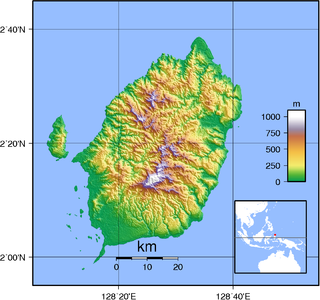
The Bombing of Darwin, also known as the Battle of Darwin, on 19 February 1942 was the largest single attack ever mounted by a foreign power on Australia. On that day, 242 Japanese aircraft, in two separate raids, attacked the town, ships in Darwin's harbour and the town's two airfields in an attempt to prevent the Allies from using them as bases to contest the invasion of Timor and Java during World War II.

RAAF Base Darwin is a Royal Australian Air Force (RAAF) military air base located in the city of Darwin, in the Northern Territory, Australia. The base shares its runway with Darwin International Airport, for civil aviation purposes. The heritage-listed RAAF Base Darwin is a forward operating base with year-round activity with approximately 400 personnel.

RAAF Base Tindal is a Royal Australian Air Force (RAAF) military air base and civil aviation airfield located 8 nautical miles east southeast of the town of Katherine, Northern Territory in Australia. The base is currently home to No. 75 Squadron and a number of non-flying units, and also hosts the Katherine Tindal Civilian Airport. First constructed in 1942, it was refurbished in the late 1960s as a "bare base" capable of being utilised when required. It was opened as a permanently manned RAAF base in 1989.
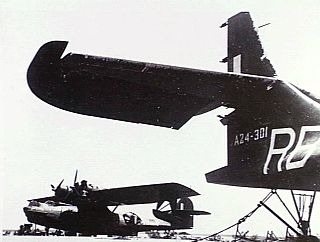
No. 42 Squadron was a Royal Australian Air Force (RAAF) mine laying and maritime patrol squadron of World War II. It was formed in June 1944 and conducted patrol and mine-laying operations over the Netherlands East Indies (NEI) from August 1944 until the war ended a year later, as well as operations in the waters off southern China in early 1945. Following the Japanese surrender, the squadron performed transport and reconnaissance flights until it was disbanded in November 1945.

No. 41 Squadron was a Royal Australian Air Force (RAAF) transport squadron of World War II. It was formed in August 1942 and operated flying boats in the South West Pacific area. The squadron was disbanded in September 1945.

No. 43 Squadron was a Royal Australian Air Force (RAAF) maritime patrol and mine-laying squadron that operated during World War II. Raised in early 1943, the squadron flew Catalina aircraft from bases in Queensland and the Northern Territory, flying mine-laying, convoy-protection and bombing sorties against Japanese targets in the Pacific theatre. These operations saw it operate as far north as the Chinese coast. After the conclusion of hostilities, the squadron was disbanded in mid-1946.

No. 13 Squadron is a Royal Australian Air Force (RAAF) squadron. The squadron saw combat during World War II as a bomber and maritime patrol squadron and is currently active as a mixed regular and reserve RAAF unit located in Darwin, fulfilling both operational support and training duties.
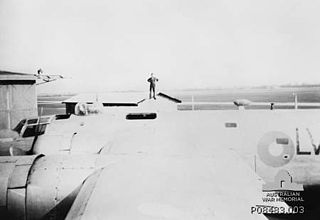
No. 201 Flight was a Royal Australian Air Force experimental electronic intelligence flight of World War II. The flight was formed in March 1945 but the first of its modified B-24 Liberator heavy bombers was not ready until July that year. As a result, while a detachment of the unit was deployed to Darwin in the Northern Territory No. 201 Flight did not conduct any operational missions before the end of the war. Following the Japanese surrender some consideration was given to retaining the flight as part of the RAAF, but it instead ceased to function in December 1945 and was disbanded in March 1946.

No. 12 Squadron was a Royal Australian Air Force (RAAF) general purpose, bomber and transport squadron. The squadron was formed in 1939 and saw combat in the South West Pacific theatre of World War II. From 1941 to 1943, it mainly conducted maritime patrols off northern Australia. The squadron was based at Merauke in western New Guinea from November 1943 to July 1944, when it was withdrawn from operations. After being re-equipped, it operated as a heavy bomber unit from February 1945 until the end of the war. The squadron continued in this role until it was redesignated No. 1 Squadron RAAF in February 1948. The squadron was reformed in 1973 to operate transport helicopters but was again disbanded in 1989.

Tennant Creek Airport is a small regional airport located near Tennant Creek, Northern Territory, Australia.
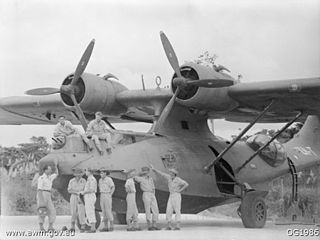
No. 111 Air-Sea Rescue Flight was a Royal Australian Air Force unit of World War II.

No. 113 Air-Sea Rescue Flight was a Royal Australian Air Force unit of World War II. The Flight was formed at Cairns, Queensland on 10 January 1945 and was equipped with PBY Catalinas for air-sea rescue operations. The Flight conducted its first operational missions in February, providing support for Allied air strikes and making supply drops. The flight departed Australia for Morotai in the Netherlands East Indies in late February, and became operational there in early March. From Morotai the Flight continued in its rescue and transport roles and also began flying missions behind Japanese lines in support of the Allied Intelligence Bureau (AIB).

Seaplane Squadron was a flying unit of the Royal Australian Air Force (RAAF) between the wars. It operated Supermarine Southampton flying boats from January 1928, as well as other types. Along with Fighter Squadron, Seaplane Squadron was a component of No. 1 Flying Training School, based at RAAF Point Cook, Victoria. Seaplane Squadron was responsible for coastal reconnaissance, training aircrew to operate seaplanes, and supporting the Royal Australian Navy. It also conducted survey flights over remote parts of Australia and mapped the Darwin–Sydney section of the Empire Air Mail Scheme route. Seaplane Squadron was disbanded in June 1939.

Charles Eaton, OBE, AFC was a senior officer and aviator in the Royal Australian Air Force (RAAF), and later served as a diplomat. Born in London, he joined the British Army upon the outbreak of World War I and saw action on the Western Front before transferring to the Royal Flying Corps in 1917. Posted as a bomber pilot to No. 206 Squadron, he was twice captured by German forces, and twice escaped. Eaton left the military in 1920 and worked in India until moving to Australia in 1923. Two years later he joined the RAAF, serving initially as an instructor at No. 1 Flying Training School. Between 1929 and 1931, he was chosen to lead three expeditions to search for lost aircraft in Central Australia, gaining national attention and earning the Air Force Cross for his "zeal and devotion to duty".
Clyde Cornwall Fenton OBE was the Northern Territory's first flying doctor. Unlike the other doctors with the Royal Flying Doctor Service of Australia, Fenton was also his own pilot. Fenton was a self-taught pilot, and flew without the aid of any navigation equipment, air charts, and often proper landing strips. He enjoys a particular renown as a unique and dashing Territory character.

No. 76 Wing was a Royal Australian Air Force (RAAF) wing that operated during World War II. Initially based in Far North Queensland, its headquarters transferred to Darwin, Northern Territory, in September 1944 to take control of three PBY Catalina units: Nos. 20, 42, and 43 Squadrons. The prime task of these squadrons was minelaying in the South West Pacific theatre, and they conducted these operations as far afield as Java, Borneo, the Philippines, and China. As well as minelaying, No. 76 Wing's Catalinas flew bombing, patrol, and transport missions, and dropped millions of propaganda leaflets in the closing months of the war. The wing headquarters disbanded in November 1945.

Peter Jeffrey, was a senior officer and fighter ace in the Royal Australian Air Force (RAAF). Born in Tenterfield, New South Wales, he joined the RAAF active reserve in 1934, and transferred to the Permanent Air Force (PAF) shortly before World War II. Posted to the Middle East in July 1940, Jeffrey saw action with No. 3 Squadron and took command of the unit the following year, earning the Distinguished Flying Cross for his energy and fighting skills. He was appointed wing leader of No. 234 Wing RAF in November 1941, and became an ace the same month with his fifth solo victory. The next month he was awarded the Distinguished Service Order for his achievements, which included rescuing a fellow pilot who had crash landed in the desert.

Northern Area Command was one of several geographically based commands raised by the Royal Australian Air Force (RAAF) during World War II. It was formed in May 1941, and covered the whole of northern Australia and Papua. Headquartered at Townsville, Queensland, Northern Area Command was primarily responsible for air defence, aerial reconnaissance and protection of the sea lanes within its boundaries. In January 1942, following the outbreak of the Pacific War, it was divided into North-Western and North-Eastern Area Commands, to counter Japanese threats to northern Australia and Papua, respectively.
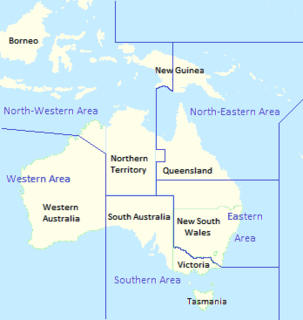
North-Western Area Command was one of several geographically based commands raised by the Royal Australian Air Force (RAAF) during World War II. Its wartime sphere of operations included the Northern Territory, adjacent portions of Queensland and Western Australia, and the Dutch East Indies. The command was formed in January 1942, following the outbreak of the Pacific War, from the western part of Northern Area Command, which had covered all of northern Australia and Papua. Headquartered at Darwin, North-Western Area Command was initially responsible for air defence, aerial reconnaissance and protection of the sea lanes within its boundaries.





